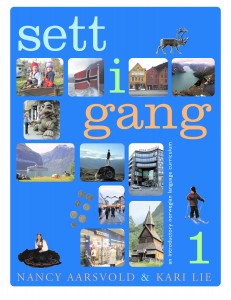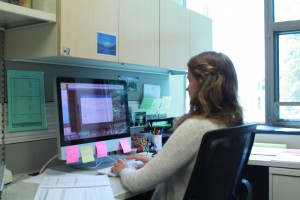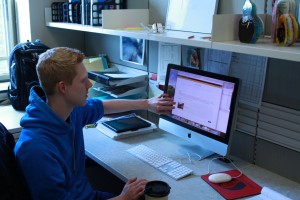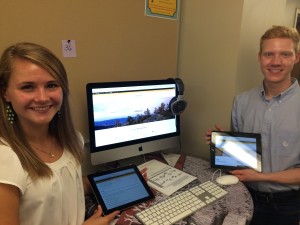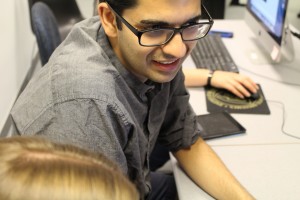This summer I worked on a collaborative, student-faculty project to create an online portal for the Sett i gang curriculum which is a part of my larger sabbatical project. But, what does that actually mean?
Between 2004-2006, I co-published a beginning level Norwegian curriculum series entitled Sett i gang together with Nancy Aarsvold. Or should I say beginning in 2001 because it’s been ongoing since we started writing? I digress… Why did we get involved in this never-ending project? Well, we still ask ourselves that too. Essentially it was because there wasn’t a curriculum that met the needs of our beginning level Norwegian students. And, although some of you out there might think why Norwegian? Well, Norwegian language learning is a thing in North America, especially at St. Olaf. Each year our department has between 350-500 students, and most, but not all, start with first year Norwegian. In 2014 for example, we have 109 students enrolled in first year Norwegian, that is more than any other first year language course at St. Olaf. Norwegian is also taught at about 25 other institutions, most of which use our curriculum as well.
So, it’s important that students have a curriculum that can provide a solid linguistic foundation but also one that motivates and stimulates their learning as well. And as soon as we humans are done greedily sucking out all the oil everywhere else in the world, everybody is going to come crying to Norway, so you might as well enroll your kids in a norskkurs now. But again, I digress…
When the Sett i gang curriculum was first written it consisted of two textbooks, two workbooks and a glossary. Additionally, there were about 400 audio clips on our website. Since the initial publication of the curriculum, technology has changed and our website has become 3 websites, none of which fully function in the way they were intended. Back to that later.
After finishing the l-o-n-g tenure process, I was rewarded with tenure, promotion and sabbatical. My sabbatical project is to update the Sett i gang curriculum, to keep it relevant. It’s an incredibly daunting sabbatical project because of its size, but also one that I am (so far) finding very rewarding. When Nancy and I wrote Sett i gang, we had to fit it in after a 50+ hour work or graduate school week, every non-teaching week during the summer and holiday breaks, and it took years. Add the time we spent to the $25,000- $30,000 we invested personally to the project for the technology, native speakers, editors, video recording sessions, renting recording studio space, travel to Norway, design work… the list goes on… and it seems a lot more doable this time around. And I feel like there’s just something else, some other reason why this time around feels so much more luxurious than when we began this process ten years ago. Let me take another sip of my espresso and savor the taste of my brioche con cioccolato on our rooftop terrace here in Italy while I try to recall what that other reason was… Oh yeah, because it will be about 60 degrees warmer than Minnesota in February.
My 2014-2015 sabbatical project consists of two main parts:
1. to write new print editions of the Sett i gang I and II textbooks
This process involves researching new statistics, finding and taking many new pictures, and some re-working of the text. Additionally, it will include some research on the feasibility of creating an e-book version of the textbooks, which is a bit tricky given the number of visuals. Although the book was initially co-authored together with Nancy Aarsvold, I’ll be doing a majority of these updates by myself, with the help of a designer. A designer that we still need to find and hire. Anyone? This part of the project I’ll begin soon and I’ll write a separate blog post about in a couple months once I’ve had some time to really sett i gang.
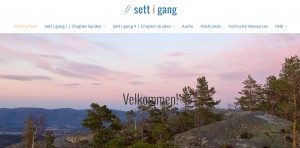 2. to create an online portal for Sett i gang
2. to create an online portal for Sett i gang
The portal was conceived over lots of coffee together with Nancy Aarsvold during the 2013-2014 academic year. We both knew early on that if we wanted to create something that utilized modern technology in a new and meaningful way for Norwegian language learners that we wouldn’t be able to do it by ourselves because it would be so time consuming and because we needed to draw on the expertise of others. Then, I began to learn more about a program at St. Olaf where faculty members works on a summer research project with a student(s) and things started to fall into place.
The Sett i gang Web Portal project thus began as a part of the 2014 St. Olaf Collaborative Undergraduate Research and Inquiry (CURI) program, a 10 week summer program at St. Olaf College which promotes collaborations between students and faculty through directed undergraduate research. Throughout the experience, students gain insight and learn how research is performed in the discipline of their choice. The program is also a good time for students to reflect and further evaluate where their skills, interests, and values best fit with their future professional endeavors. The Sett i gang Web Portal fits these goals by focusing on the scholarship of teaching and specifically the intersection between Applied Linguistics and Educational Technology.
I facilitated the project during summer 2014, which meant working 30-50 hours each week with the two St. Olaf CURI students, Jens Bringsjord and Nora Serres, who each devoted 400 hours each to the project (40 hours a week). These two CURI students were diligent analytical thinkers who became very skilled at figuring out new ways in which design and technology can enhance the language learning process. Before we started the project, Nancy and I had done enough research on platforms and templates to know that we wanted to use WordPress with a plugin called LearnDash. As none of us were familiar with LearnDash, Jens and Nora dove right in to learn as much as they could about the program and designed and built the portal from scratch. This, in itself, was quite the feat.
The Sett i gang portal is a website that brings many useful language learning resources together in one site for first year Norwegian language learners. This includes audio and videos materials (over 500 clips), flashcards (which we had before but are now embedded into our website and now have audio embedded), over 500 interactive activities for language learning (which replaces and expands upon the print workbooks), resources for instructors and links to other resources of interest to the learner and instructor. It is designed to work on both computers and tablets.
If it wasn’t clear before, the portal is HUGE; it has about 1000 pages right now; most pages have a significant amount of programming to support interactive exercises for learning. Creating a template for this large of a project was an incredibly large task which involved multiple rounds of feedback from students, programmers, professors, IT staff, etc. Additionally, we had to create a behind-the-scenes data management system to keep all the data sorted and organized. To organize all the data we created two main google docs, one for each book, with a sheet for each chapter where we have recorded detail after detail of updates. Essentially, there are over 9,000 cells where we have recorded the information needed to create, revise and further revise each piece of the portal. And, if you know me and know that I had a hand in developing this madness, you’re not surprised that it is also all color coordinated so it’s easy to see who needs to work on which cell (task). So, just the creation of this data management system, which nobody other than the developers will see, was a monumental accomplishment.
After the template and the data management system was in place, most of the tasks for the creation of the portal were divided to draw on the skills and interests of each of the students. Nora focused the majority of her time on developing the online, interactive quizzes within the portal and by doing this has become our LearnDash expert, which is the largest and most time-consuming part of our project. I met with Nora several times a week to discuss how and what needed to be changed from the existing print workbook, what technological tools would best match the needs of the students with the linguistic function they are working on, and ideas of expanding each chapter. Nora then created the interactive exercises in LearnDash, we often went through several rounds of editing and fine tuning and then we finally went over each to make sure they accomplished their intended goal.
Nora is a junior at St. Olaf who grew up in the US with a Norwegian mother and thus has spoken Norwegian her entire life. Nora has been a student grader in our department, a tutor for students enrolled in Norwegian and her experiences in Norway have given her unique cultural and linguistic insight. These experiences combined with her Psychology Major, Linguistics and Neuroscience Concentrations made her a perfect fit for the program.
Jens was the WordPress and design guru. Jens focused his time on the WordPress elements of the site. His part of the project involved a lot of work on how the portal looked visually and how learners navigate and experience the site as language learners, thinking about how design can assist language learning. In practice this meant that he was constantly juggling 20 different tasks at the same time, it was much less linear than Nora’s.
Jens came to the project having just finished first year Norwegian at St. Olaf and having developed several websites prior to ours. Having one member of the team who just finished the curriculum that we are further developing was incredibly useful. He knew what resources were helpful to him, how he and his classmates used the curriculum and brought a significant amount of design and technology know-how to the project.
I met several times a week with Jens to go over pieces of the portal. We spent time examining the various elements of the portal each meeting, from navigation to specific tools (i.e. the audio, the tutorials, the flashcards, the intro chapter videos, the teacher resources, etc.). For these pieces of the portal, we talked over ideas, he developed a draft or template which we then test and revise and then we test again and often revise another time, and sometimes yet again. Jens actually just decided to transfer to pursue a graphics design program that St. Olaf doesn’t offer. It’s a huge loss for St. Olaf, but the skills he developed this summer and will through his academic switch are ones be utilized in a variety of ways in the future.
The CURI program is a unique program at St. Olaf. It not only offers students the opportunity to conduct collaborative research with faculty members as undergraduate students (a rarity, especially in the humanities) but it also provides a weekly $430 stipend and a room on campus for the summer, a pretty decent summer gig. The program also has a number of opportunities set up for all student researchers such as facilitated bag lunch discussions and project presentations that Jens and Nora participated in to further their knowledge of how research is conducted and presented and also to think about how they might further their studies in graduate programs.
And while it was a great opportunity for the students, it was also a great professional opportunity for me as a faculty member as well. I believe that student-collaborated research is more than just an academic buzzword, I’m pretty sure it’s going to stick around for awhile. Additionally, it’s something that St. Olaf prides itself on. I looked at this program as an opportunity to transition from connecting theory and practice in my own scholarly work to facilitating student inquire into how theory and practice meet in interdisciplinary research, which also seems to be a natural progression from my previous scholarship.
One of the great aspects of the CURI program, for our project, was the multiple ways in which the three of us were able to learn from and work together with IT staff and their student interns. This was largely due to a generous Mellon Foundation grant, a four-year, $700,000 grant, known at St. Olaf as The Digital Humanities on the Hill. During the second week of our CURI project we participated in an on-campus 3 day summer institute “Digital Design & Practice for Teaching & Research”. The presentations and guidance gave us a plethora of ideas and feedback as to what our design would look like and how our users would navigate through our site. Recovering from a car accident which gave me vision problems, I couldn’t do as much this week, but the CURI students worked like crazy developing a template for our portal and to learn the ins and outs of the plug-in that we had decided on, LearnDash.
When we had an issue or a question come up that we couldn’t figure out, we were fortunate to have an incredible amount of support from IT. Nancy, who now works as the Assistant Director of Instructional Technology, was able to give us a lot of guidance. She obviously knows the curriculum well and that combined with her knowledge of effective pedagogical use of technology has been extremely beneficial. Additionally, Ben Gottfried, St. Olaf’s Multimedia Instructional Technologist worked with us to help us develop our design and navigational features. We’ve gone to both Nancy and Ben with questions on a more-than-we’d-like-to-admit basis and have all learned a lot from their feedback.
But we were also incredibly fortunate that IT hired a number of students to work as Digital Humanities Interns with projects like ours over the summer. We utilized their knowledge on a daily basis. One student in particular we were extremely fortunate to work with was Armaan Bindra. Armaan is a fixer of problems large and small. He acted as our first call when we ran into a problem that we didn’t know how to fix. His quick thinking and very well-developed analytical skills made for some very helpful talking-out-the-problem-and-figure-out-a-solution sessions. Other IT interns have been tremendously vital to the project as well, including Annika Fredrickson, Nathan Hartwig, Maddy Rose, Sonja Nelson, Clara Lee, Rebecca Kunau, Lauren Kingsbeck. All of these students played an important role in developing the portal.
So, it’s now October, a couple months have passed since we worked countless hours on the portal… and also quite a few hours after the official end date. Did we finish? Nope. We aren’t as far as we thought we’d be because we had a number of incredibly time consuming technical issues to deal with along the way. The CURI students have now transitioned back to their academic year studies and I am figuring out where to go from here. So, that leaves the portal with maybe ⅔ of the work complete and with some exciting possibilities of further growth already conceived. Luckily, I just found out this week that Armaan, one of the interns who worked on the portal over the summer, is still employed by IT and will work on the portal this semester. What a huge relief! It’s going to need far more work than what he can do during student work times, but it is a start. Finishing large, meaningful projects seems to be one of the biggest challenges with scholarship in academia; even with so many resources over the course of the summer, it just wasn’t quite enough. I do have my sabbatical year, which offers some flexibility, but the majority of my year needs to be spent on the print revisions of the textbooks.
But even though the project it isn’t entirely finished, it has gone live with four universities piloting it in a total of ten classes this fall (five at St. Olaf, two at the University of Wisconsin Madison, two at the University of North Dakota Grand Forks and one at Augsburg College). This (the piloting) is also an essential part of a successful final product. Having this dedicated group of instructors and their students test the portal out and from whom to get feedback on an almost daily basis is the best way the portal can be perfected at this point. Based on their feedback and the notes from where we left off from the summer, I’ve been spending my days fixing problems, adding to resources, and making a (long) list of the things that I need help with, a combined finishing-up and piloting stage of the portal. This feels like the master juggler phase of the project. There is so much going on, it’s difficult to keep everything straight. This is when I think, what would we have done if we didn’t create our extensive data management system? If I didn’t have this management system every fix or addition would take 10x longer. I’m also getting my ducks in a row to head to Norway in a few weeks by revising a long list of pictures which the portal and textbooks need. This is another data management system the CURI students developed with me, consisting of about 1,000 cells, so it’s a wee bit little easier to manage. But now I’m working with both and things are getting jumbled in my hode.
So, I thought it was a good time to take a step back to reflect, write, and assess where things are at, figure out where my time is best utilized and how I should move forward. Soon I’ll write a bit more about the research behind the portal, specifically how a curricular project can provide a meaningful research experience for both faculty and students. But, this post is long enough.
If you are interested in checking out the portal, velkommen skal du være. You will need to create an account, but it is free to do so. Oh yeah, I didn’t even mention that students get to use the portal for free.

